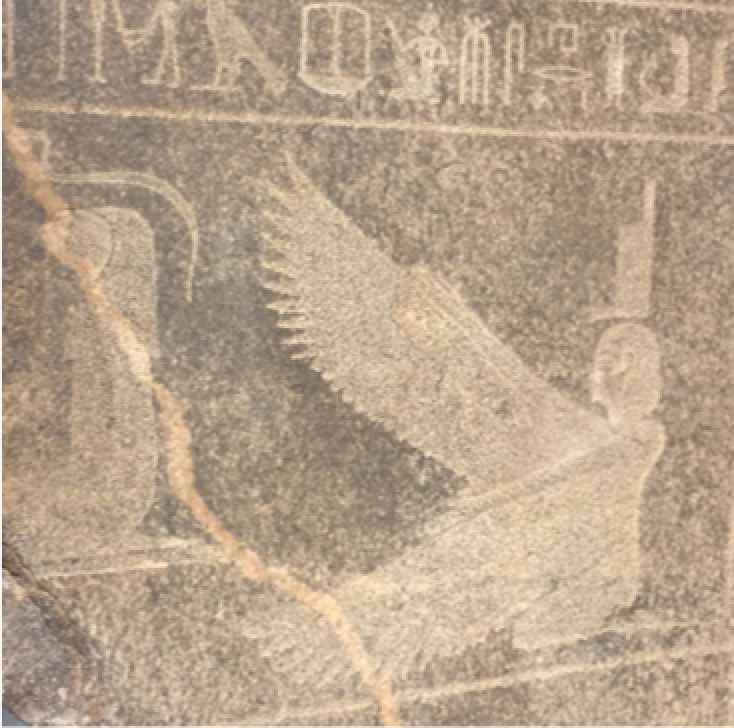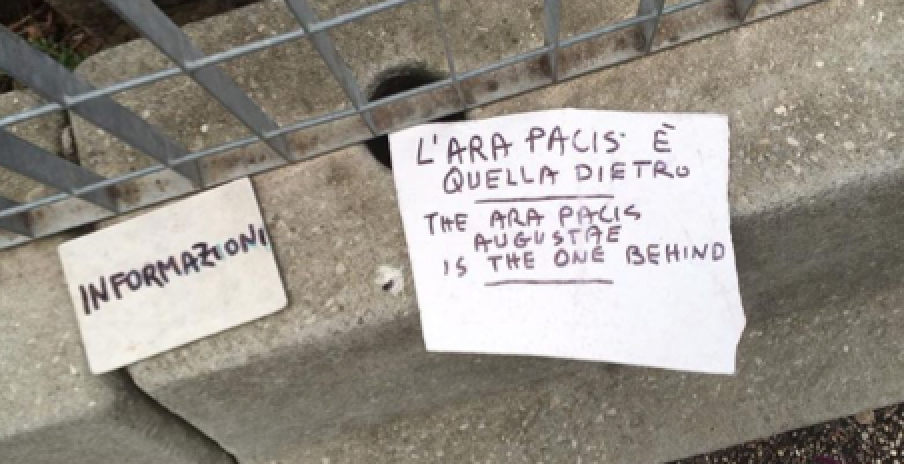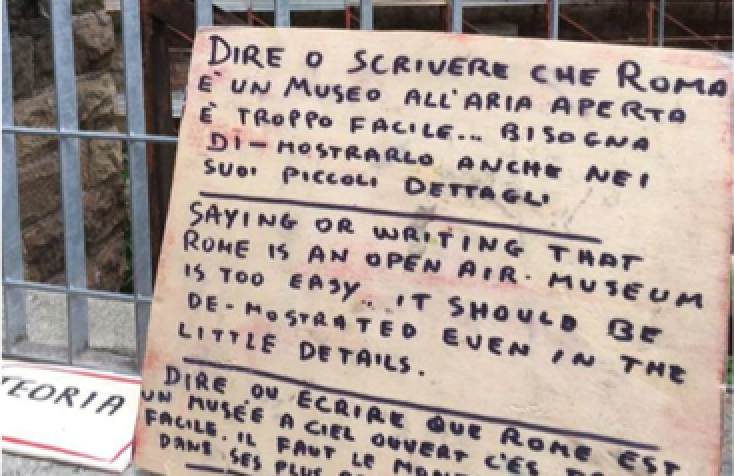This month’s blog has been written by Freya Burford, a postgraduate student who studied at Kent’s Rome Centre earlier in the year. She investigates a statue that drew her attention at the very centre of Rome, which many simply pass by as they travel to the Capitol or the Forum Romanum.
Hidden in the furthest corner of Piazza San Marco in Rome there is a somewhat disfigured statue of the goddess Isis. In Rome, it is not surprising to find the remains of a column or a pile of rubble collected at the side of the street, however, this statue is immediately curious for several reasons. In the adjoining piazza, the National Monument to Victor Emmanuel II dominates the neighbourhood and in the shadow of this elaborate structure, the battered statue of Isis looks rather out of place. Yet, mounted upon a podium, her position alludes to some sort of importance. What is the role of this statue, why does she occupy a place in the heart of Rome?
The bust has no official signage but is known to the locals as ‘Madama Lucrezia’. She is identified with Isis because of the knot in the centre of her garment, indicating the goddess herself, or one of her priestesses. Although Isis originated in Egyptian religion, this statue depicts a very different representation of the goddess than the one familiar to Egyptian art, which can be seen in the images below.
 ‘Madama Lucrezia’. Rome. Photo: Freya Burford.
‘Madama Lucrezia’. Rome. Photo: Freya Burford.
Funerary Monument. Naples Archaeological Museum. Photo: Freya Burford.
It is not clear when Isis underwent these changes, but there are indications in Greek and Latin literature. Herodotus (484-426BC) relates Isis to the Greek goddess Io (Htd 2.41.2), suggesting that she was influenced by Greek religion. In Rome, it is difficult to trace the first contact with the goddess, but by the end of the Republican period she had worshippers in the city. As early as 43BC, there were plans to create a temple to Isis in Rome (Cass. Dio. 47. 15-16). The contact with other societies may have influenced the depiction of Isis, furthermore creating the image of Isis that can be seen with Madama Lucrezia. The statue appears to have been part of the Iseum on the Campus Martius (see description). However, there are no archaeological accounts relating to her excavation, therefore it is not possible to trace her exact position.
Despite these issues, the reception of Madama Lucrezia in later periods offers a more promising area of study. In 1501 Cardinal Oliviero Carafa excavated a statue depicting Menelaus and positioned him in a piazza, not far from Piazza Navona. The statue was used in annual literary competitions, which involved Latin epigrams being stuck to the statue. The Romans referred to this statue as Pasquino, thus the epigrams were known as pasquinades. The tradition developed through papal Rome and the epigrams began to be used to criticise the popes. One example directed towards Pope Urban VIII Barberini (1623-1644), demonstrates the criticism that these statues could be used to project: ‘What the Barbarians did not do, the Barberini did’(translation by Jones et al 2013: 630). This pasquinade was directed to the Pope for taking the bronze tiles from the ceiling of the Pantheon for St Peter’s Basilica. By comparing this action to that of a barbarian, the epigram is expressing criticism of the Pope. This use shows the statue operating as a platform to openly, yet anonymously, critique to those in power.
As the tradition developed, other statues began to join Pasquino to form a satirical ensemble. They provided a place where Romans could communicate within the political life of the city, operating like a political forum open to all who could write. It is also quite reasonable that, as the tradition developed, the inhabitants of Rome would have had an awareness of these talking statues. Newsome recounts the pasquinade tradition, noting that ‘it appears to be read at night and circulated by day’ (Newsome 2013: 65). Consequently, whilst the initial inscribing required a level of literacy, the association and circulation of these pasquinades did not.
A recent article, attests to the continuation of pasquinades, as a group of Italians claim to be reviving ‘Rome’s ancient tradition of publicly criticising those in power’ (BBC). The group were outraged at the behaviour of the Prime Minister Silvio Berlusconi, and so they attached messages to a variety of statues within Rome. As recently as 2017 this tradition is observable within Rome, in the images below of multilingual pasquinades found at the Augustan Mausoleum. Although the concept now includes additional ancient sites, statues and languages the concept of publicly criticising the actions of those in power remains the same.
Pasquinades Augustus’ Mausoleum. Rome. Photo: Freya Burford.
Returning to Madama Lucrezia, her identification as a talking statue is intriguing for another reason. It is particularly striking that within the reception of this statue, there does appear to be an element of continuity. Isis was associated with her husband and brother, Osiris and their child Horus. Therefore, Isis is depicted as the ideal mother and connected with healing and salvation. In a text known as an aretalogy, Isis declares her own divine qualities as having ‘established penalties for those who practice injustice’ (see aretalogy). Additionally, in mythology, Isis’ lover Osiris was murdered and scattered throughout Egypt, before she collected his body and brought him back from the dead. Isis’ role was to protect her partner until he could claim back the throne, which was then granted to their son, Horus. Isis is identified with those who have suffered political injustice, the subjugated and mistreated. In this position, she appears rather like the role of Madama Lucrezia as a Pasquino, again aiding those who have suffered a political wrong.
Additionally, Cassius Dio (155-235AD) mentions that the statue of Isis in the Iseum turned its head towards the interior of the temple in 220AD (79.10.1). In this part of his work Dio is retelling the various scandals of Elagabalus (emperor 218-222AD), and regards the movement of the statue as one of many warnings which occurred in Rome at the time. Whilst Dio is evidently constructing the negative behaviours of Elagabalus, the description offers an insight into the role of the statue. Dio incorporates the movement of the statue as an indication of political unrest, rather like the Italians who used pasquinades against the political scandals of the Prime Minister. These similarities allude to some continuity between the traditional attributes of Isis and Madama Lucrezia.
In conclusion, the statue of Isis in Piazza San Marco is a figure of importance. She stands as a visual representation of the pasquinade tradition, but also as a figure reminiscent of her former religious attributions. Although it is likely that the selection of the ‘talking statues’ was random, it is nevertheless intriguing that a goddess so intertwined with justice and political power, finds herself retaining at least an element of her former identification.
Further Reading
For further reading on the goddess Isis in the Roman Empire, see Bricault (2013). Although his work is in French, it offers the best collection of literary documents relating to the goddess in the Greco-Roman world. Also, Donalson (2003), focusing solely on Isis in the Roman world, offers another good overview in English. For reading relating to the pasquinade tradition, see Gilbert (2015) for the most recent and informative article. The pasquinade tradition has also been noted by various newspaper articles which are in the bibliography.
Cassius Dio. Roman History. Translated by Cary, E. [online] http://penelope.uchicago.edu/Thayer/E/Roman/Texts/Cassius_Dio/80*.html#79-10.
Herodotus. Histories. Translated by Godley, A. D. [online] http://www.perseus.tufts.edu/hopper/text?doc=Perseus%3Atext%3A1999.01.0126%3Abook%3D2%3Achapter%3D41%3Asection%3D2.
Iseum Campense. Found in Planter, S. B. Ashby, T. (1929) A Topical Dictionary of Ancient Rome. London, Humphrey Milford: Oxford University Press. [online] http://www.perseus.tufts.edu/hopper/text?doc=Perseus:text:1999.04.0054:entry=isis-aedes&highlight=iseum.
Kyme Aretalogy. Translated by Fredericks, L. R. [online] http://www.lrfredericks.com/wp-content/uploads/2011/05/The-Kyme-Aretalogy.pdf.
Alvar, J. (2008) Romanising oriental gods: Myth, salvation, and ethics in the cults of Cybele, Isis, and Mithras. Edited by Richard Gordon. New York: Brill.
BBC (2011), ‘Anti-Berlusconi ‘talking’ statues appear in Rome’ BBC Europe [online]. Available from: http://www.bbc.co.uk/news/world-europe-12398591.
Bommas, M. (2012), ‘Isis, Osiris, and Serapis’ from Riggs, C. (2012). The Oxford Handbook of Roman Egypt. Oxford: Oxford University Publishing, pp. 114-136.
Bricault, L. et al. (2006) Nile into Tiber: Egypt in the Roman World: Proceedings of the IIIrd International Conference of Isis Studies 2005. Leiden: Brill Publishing.
Bricault, L. (2013) Les Cultes Isiaques dans le monde Gréco-Romain. Les Belles Lettres.
Coarelli, F. (2007), Rome and Environs, An Archaeological Guide. Berkeley and Los Angeles, California, University of California Press.
Donalson, M.D. (2003) The cult of Isis in the Roman Empire: Isis Invicta. United States: Edwin Mellen Press.
D’Onofrio, C. (1990). Un Popolo di Statue Racconta: Storie, Fatti, Leggende della Città di Roma Antica, Medievale, Moderna. Roma: Romana Società Editrice.
Fowler, S. (2002), ‘Here, statues don’t always stand mute’ Chicago Tribute [online]. Available from: http://articles.chicagotribune.com/2002-02-22/news/0202220376_1_statues-eternal-city-romans.
Gilbert, C. J. (2015), ‘If this statue could talk: Statuary satire in the Pasquinade tradition’. Rhetoric and Public Affairs, Volume 18(1), 79.
Gumbel, A (1998), ‘Talking Statue Gives Voice to Italy’s Latest Sex and Corruption Scandal’ The Independent [online]. Available from: http://www.independent.co.uk/news/talking-statue-gives-voice-to-italys-latest-sex-and-corruption-scandal-1141904.html.
Jones, T. D. et al. (2013). The Oxford Dictionary of Christian Art and Architecture. Oxford University Press: Oxford.
Newsome, D. J. (2013) ‘Movement, Rhythms and the (Re)production of Written Space’ Keegan, P. et al. Written Space in the Latin West, 200BC-AD300. London: Bloomsbury Academic, pp. 65-83.
Rice, L. (2008) ‘Bernini and the Pantheon Bronze’ Satzinger, G. and Schütze, S. Sankt Peter in Rom 1506-2006. Beiträge der Internationalen Tagung vom 22. – 25. February 2006. Munich: Hirmer, pp. 337-352.
Squires, N. (2017) ‘Giant Mausoleum in Rome that held the Remains of the Emperor Augustus to be restored after decades of neglect’ The Telegraph [online]. Available from http://www.telegraph.co.uk/news/2017/01/16/giant-mausoleum-rome-held-remains-emperor-augustus-restored/ [Accessed March 2017].


